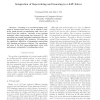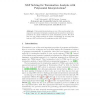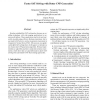100
click to vote
CP
2008
Springer
15 years 2 months ago
2008
Springer
Abstract. Work by Kilby, Slaney, Thiebaux and Walsh [1] showed that the backdoors and backbones of unstructured Random 3SAT instances are largely disjoint. In this work we extend t...
111
click to vote
ECAI
2006
Springer
15 years 2 months ago
2006
Springer
Propositional satisfiability (SAT) is a success story in Computer Science and Artificial Intelligence: SAT solvers are currently used to solve problems in many different applicati...
114
click to vote
MEMOCODE
2003
IEEE
15 years 6 months ago
2003
IEEE
— Modern SAT solvers have proved highly successful in finding counterexamples to temporal properties of systems, using a method known as ”bounded model checking”. It is natu...
ASPDAC
2005
ACM
15 years 6 months ago
2005
ACM
Abstract— Learning is an essential pruning technique in modern SAT solvers, but it exploits a relatively small amount of information that can be deduced from the conflicts. Rece...
SAT
2007
Springer
15 years 7 months ago
2007
Springer
Abstract. Polynomial interpretations are one of the most popular techniques for automated termination analysis and the search for such interpretations is a main bottleneck in most ...
100
click to vote
SAT
2009
Springer
15 years 7 months ago
2009
Springer
Minimizing learned clauses is an effective technique to reduce memory usage and also speed up solving time. It has been implemented in MINISAT since 2005 and is now adopted by mos...
103
click to vote
DATE
2009
IEEE
15 years 7 months ago
2009
IEEE
Boolean satisfiability (SAT) solving has become an enabling technology with wide-ranging applications in numerous disciplines. These applications tend to be most naturally encode...
213
click to vote
CP
2009
Springer
16 years 1 months ago
2009
Springer
In this work, we improve on existing work that studied the relationship between the proof system of modern SAT solvers and general resolution. Previous contributions such as those ...
116
click to vote
DAC
2004
ACM
16 years 1 months ago
2004
ACM
Bounded Model Checking (BMC) relies on solving a sequence of highly correlated Boolean satisfiability (SAT) problems, each of which corresponds to the existence of counter-example...







